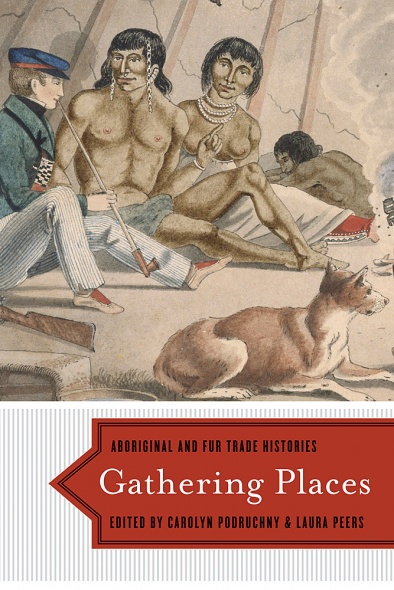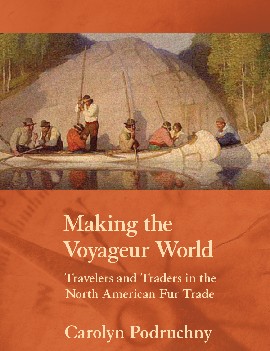Gathering Places: Aboriginal and Fur Trade Histories, edited by Carolyn Podruchny and Laura Peers

(Vancouver: University of British Columbia Press, 2010).
British traders and Ojibwe hunters. Cree women and their metis daughters. Explorers and anthropologists and Aboriginal guides and informants. These people, their relationships, and their complex identities and worldviews were not featured in histories of North America until the 1970s, when scholars from multiple disciplines began to bring new perspectives and approaches to bear on the past.
Gathering Places presents some of the most innovative and interdisciplinary approaches to metis, fur trade, and First Nations history being practised today. Whether they are discussing dietary practices on the Plateau, trees as cultural and geographical markers in the trade, the meanings of totemic signatures, issues of representation in public history, or the writings of Aboriginal anthropologists and historians, the authors link archival, archaeological, material, oral, and ethnographic evidence to offer novel explorations that extend beyond earlier scholarship centred on the archive. They draw on Aboriginal perspectives, material forms of evidence, and personal approaches to history to illuminate cross-cultural encounters and challenge older approaches to the past.
The diverse chapters in this volume take this disciplinary history as their starting point and show the new directions in which Aboriginal history is moving. They highlight issues associated with the new methodology, especially the close reading and use of disparate kinds of sources -- archival, oral, material, and fieldwork data -- in tandem. They explore cross-cultural and intracultural issues of power, both in the past and in the production of scholarly knowledge in the present. They focus on the fine-grained and local as well as the broader patterns into which such case studies fit. They are reflexive about scholarly perspective, both professional (especially the cross-disciplinary use of anthropological theory and historical data) and personal, including the knowledge and stance gained from family and cultural background and experience.
The chapters explore these themes with reference to the work of one scholar, Jennifer S.H. Brown, whose publications embody these themes and have been instrumental in producing major developments in Aboriginal historiography. All of the people and topics introduced at the beginning of this chapter have featured in her work, and all of the contributors to this volume have been influenced by Brown’s work, as much by the impact of her publications as through her mentorship. In the following pages, we articulate the relationship between these broad disciplinary developments, Brown’s work, and the essays presented here.
Table of Contents:
1. “‘Complex subjectivities, multiple ways of knowing’: Introduction” by Laura Peers and Carolyn Podruchny
Section 1: Using Material Culture
2. “Putting Up Poles: Power, Navigation, and Cultural Mixing in the Fur Trade” by Carolyn Podruchny, Frederic W. Gleach and Roger Roulette
3. “Dressing for the Homeward Journey: Western Anishnaabe Leadership Roles Viewed Through Two Nineteenth-Century Burials” by Cory Willmott and Kevin Brownlee
Section 2: Using Documents
4. “Anishinaabe ‘toodaims’: Contexts for Politics, Kinship and Identity in the Eastern Great Lakes” by Heidi Bohaker
5. “The Contours of Everyday Life: Food and Identity in the Plateau Fur Trade” by Elizabeth Vibert
6. “ ‘Make it last forever as it is’: John McDonald of Garth’s Vision of a Native Kingdom in the North-West” by Germaine Warkentin
Section 3: Ways Of Knowing
7. “Being and Becoming Métis: A Personal Reflection” by Heather Devine
8. “Historical Research and the Place of Oral History: Conversations from Berens River” by Susan Elaine Gray
Section 4: Ways Of Representing
9. “Border Identities: Métis, Halfbreed and Mixed-blood” by Theresa Schenck
10. “Edward Ahenakew’s Tutelage by Paul Wallace: Reluctant Scholarship, Inadvertent Preservation” by David R. Miller
11. “Aboriginal History and Historic Sites: The Shifting Ground” by Laura Peers and Robert Coutts
Afterword
12. “Aaniskotaapaan, Generations and Successions” by Jennifer S. H. Brown
Buy The Book Online
Making the Voyageur World: Travelers and Traders in the North American Fur Trade
(Lincoln: University of Nebraska Press and Toronto: University of Toronto Press), 2006.
French Canadian workers who paddled canoes, transported goods, and staffed the interior posts of the northern North American fur trade became popularly known as voyageurs. Scholars and public historians alike have cast them in romantic roles of rugged and merry heroes who paved the way for European civilization in the wild northwest. This book looks past the stereotypes and reveals the contours of voyageurs' lives, world views, and values. Making the Voyageurs' World argues that voyageurs created distinct identities shaped by their French-Canadian peasant roots, the Aboriginal peoples they met in the northwest, and the nature of their workplace as indentured servants in diverse environments. Voyageurs' identities were also shaped by the liminality inherent in their constant travels and by their own masculine ideals that emphasized strength, endurance and daring. Although voyageurs left few conventional traces of their own voices in the documentary record, an astonishing amount of information can be found in descriptions of them by their masters, explorers and other travelers.
My interest in voyageurs began with a desire to contribute to the history of plebeian peoples who did not leave a documentary record, yet who had a significant impact on the social and cultural landscape of early North America. French Canadian voyageurs traveled vast distances over the continent and left a significant legacy. French was one of the main languages among Europeans and Euro-Americans in the Montreal fur trade until the mid-nineteenth century, and its presence today is reflected in place names across the continent. Many voyageurs formed kinship ties with Aboriginal people and settled in the northwest to raise their families. A large portion of métis people had French ancestry. Dozens of francophone communities exist in northwestern North America today and a large part of these descended from fur trade families. Today, voyageurs are highly visible as colorful caricatures in popular culture and history, but they have rarely been the subject of serious study. The fragmented nature of sources on voyageurs, and their subjugation in commercial and political arenas has confined them to the peripheries of most historical narratives. This book places French Canadian voyageurs squarely in the center of historical narrative as serious people with compelling stories and lasting consequences. The book devotes considerable attention to Aboriginal and mixed-blood or métis peoples, but only in the context of their relationship to French Canadian voyageurs.
Table of Contents
- Introduction: Sons of the Farm, the Trade, and the Wilderness
- Leaving Home: Family and Livelihood in French Canada and Beyond
- Rites of Passage: Voyageur Cosmology
- It is the Paddle That Brings Us: Voyageurs Working in Canoes
- The Theater of Hegemony: Masters, Clerks, and Servants
- Rendezvous: Parties, Tricks, and Friendships
- En Dérouine: Life at Interior Fur Trade Posts
- Tender Ties, Fluid Monogamy, and Trading Sex: Voyageurs and Aboriginal Women
- Disengagement: Going Home and Going Free
- Conclusion: Carrying the World
Buy The Book Online
Decentring the Renaissance: Canada and Europe in Multidisciplinary Perspective, 1500-1700, edited by Germaine Warkentin and Carolyn Podruchny
(Toronto: University of Toronto Press, 2001).
In 1497, explorers from the confident world of Renaissance Europe sailed, under Captain Giovanni Caboto, into what are now Canadian waters. This significant encounter brought into contact two worlds equally ignorant of each other and set in motion a number of events that culminated in the birth of a new nation. The Renaissance, ordinarily thought of as an entirely European-centred phenomenon is 'de-centred' in these eighteen innovative essays. They explore not only how the European Renaissance helped form Canada, but also how more significantly the experience of Canada touched the Renaissance and those who first came to the shores of North America.
Representing a range of disciplines, including literature, anthropology, biology, history, linguistics, and anthropology, this work re-thinks traditional notions of Canada and of the Renaissance. The essays examine both the interaction between the two worlds as well as the ways that this interaction has traditionally been interpreted. As distinct from the rapid transformation of South and Central America, the focus is on the slower northern experience, questioning the European monopoly on history, politics, and science, as well as the misrepresentation of Canada's Aboriginal peoples. Originally presented at a 1996 conference at the Centre for Reformation and Renaissance Studies, University of Toronto, these essays provide a wealth of new information and a variety of new perspectives on the collision of the Old World with the New.
Table of Contents:
1. “Introduction: ‘Other Land Existing’ by Germaine Warkentin and Carolyn Podruchny
Part I. Methods
2. “Polarities, Hybridities: What Strategies for Decentring?” by Natalie Zemon Davis
3. “Inclusive and Exclusive Perceptions of Difference: Native and Euro-Based Concepts of Time, History, and Change” by Deborah Doxtator
4. “Plunder or Harmony? On Merging European and Native Views of Early Contact” by Toby Morantz
5. “Memoria as the Place of Fabrication of the New World” by Gilles Thérien
Part II. Mentalités / Debwewin
6. “The Sixteenth-Century French Vision of Empire: The Other Side of Self-Determination” by Olive Patricia Dickason
7. “The Mentality of the men behind Sixteenth-Centuiry Spanish Voyages to Terranova” by Selma Huxley Barkham
8. “Relocating Terra Firma: William Vaughan’s Newfoundland” by Anne Lake Prescott
9. “Images of English Origins in Newfoundland and Roanoke” by Mary C. Fuller
10. “From the Good Savage to the Degenerate Indian: The Amerindian in the Accounts of Travel to the New World” by Réal Ouellet with Mylene Tremblay
Part III: Translatio fide
11. “Few, Uncooperative, and Ill Informed? The Roman Catholic Clergy in French and British North America, 1610-1658” by Luca Codignola
12. “Canada in Seventh-Century Jesuit Thought: Backwater or Opportunity” by Peter A. Godard
13. “’A New Loreto in New France’: Pierre-Joseph-Marie Chaumonot, SJ. and the Holy House of Loreto” by André Sanfaçon
Part IV: Decentring at Work
14. “The Delights of Nature in This New World: A Seventeenth-Century Canadian View of the Environment” by Lynn Berry
15. “The Beginning of French Exploration out of the St. Lawrence Valley: Motives, Methods, and Changing Attitudes towards Native People” by Conrad E. Heidenreich
16. “The Earliest European Encounters with Iroquoian Languages” by Wallace Chafe
17. “Decentring Icons of History: Exploring the Archaeology of the Frobisher Voyages and Early European-Inuit Contact” by Réginald Auger, William W. Fitzhugh, Lynda Gullason, Anne Henshaw, Donald Hogarth, and Dosia Laeyendecker
Buy the Book Online


